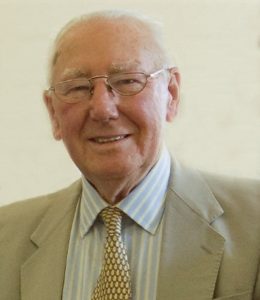 Frank Stone’s death on March 5th deprived the scientific community of an elder statesman, famed for studies of catalysis and solid-state chemistry. Born in 1925 in Bristol, England, and educated at Queen Elizabeth’s Hospital School, Bristol, he excelled in Classics and Sciences, but preferred the latter, studying Chemistry at the University of Bristol; graduating with first class honours in 1945.
Frank Stone’s death on March 5th deprived the scientific community of an elder statesman, famed for studies of catalysis and solid-state chemistry. Born in 1925 in Bristol, England, and educated at Queen Elizabeth’s Hospital School, Bristol, he excelled in Classics and Sciences, but preferred the latter, studying Chemistry at the University of Bristol; graduating with first class honours in 1945.
He undertook postgraduate research with Professor W. E. Garner, linking the catalytic activities of binary inorganic oxides with their semi-conducting characteristics. Thereafter, he proceeded to post-doctoral studies in photochemistry at Princeton University, USA, with the distinguished physical chemist, Hugh S. Taylor. Returning to Bristol, he investigated heterogeneous catalytic reactions through adsorption calorimetry. The importance of the “electronic factor” to heterogeneous catalysis led Stone to doping binary oxides with the alter-valent ions, and to measuring the magnetic properties of ternary oxides. Enduring associations were established with Italian and Spanish research groups; notably with Alessandro Cimino, a contemporary at Princeton, at the Universities of Perugia and Rome, assessing specific catalytic activities of isolated surface ionic sites; and with co-workers of J. F. Garcia de la Banda (CSIC, Madrid), who worked previously with Garner, to study the cracking of hydrocarbons on transition metal-doped zeolites. Between 1955–65, Frank Stone pioneered research on heterogeneous photocatalysis on finely-divided oxides, solid-state reactions for spinel formation, and adsorption on supported metallic particles.
He became European Editor of the Journal of Catalysis in 1970, a task at which he excelled for 26 years, in which his literary acumen and facility with foreign languages earned him huge respect, especially from non-English-speaking authors, who were grateful to him for his tactful suggestions for improving manuscripts.
In 1972 Frank Stone became Professor of Physical Chemistry at the University of Bath, where, with Adriano Zecchina and Edoardo Garrone of the University of Turin, he applied UV-Visible Diffuse Reflectance- and Infra-Red Spectroscopies to oxide surfaces of alkaline-earth elements, identifying 3‑, 4‑, and 5‑fold coordinated adsorption sites, and revealing a pink oligomeric form of adsorbed carbon monoxide. In later years he held the position of Pro-Vice-Chancellor. Frank Stone was an outstanding lecturer. He authored more than 120 scientific papers; many have withstood the “wear of time”. He was a founding- committee member of the triennial Rideal Conference Series, and was a regular attendee until 2011/12.
He met his future wife, Joan, also a student, in wartime Bristol. They became volunteer fire-watchers, studying by day and fulfilling their night-time duties from the rooftops of the University buildings. A family man, who enjoyed gardening, cycling, and travel. He took many camping holidays across Europe, a practice continued until late in life and held annual summer camps for his research group in the Welsh Mountains or on Exmoor. He was a regularly-attending member of the Bristol Scientific Society until shortly before his death.
Roger I. Bickley
Bradford, West Yorkshire, UK